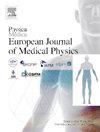Dosimetric optimization and evaluation of hepatocellular carcinoma treatment effect prediction in Y-90 radioembolization
IF 3.3
3区 医学
Q1 RADIOLOGY, NUCLEAR MEDICINE & MEDICAL IMAGING
Physica Medica-European Journal of Medical Physics
Pub Date : 2025-05-09
DOI:10.1016/j.ejmp.2025.105000
引用次数: 0
Abstract
Background
Liver transarterial radioembolization (TARE) with 90Y microspheres is a common treatment for hepatocellular carcinoma (HCC). A pre-treatment SPECT/CT dosimetric study is performed using 99mTc macroaggregated albumin, followed by PET-based dosimetry to assess dose distribution of 90Y. Recent studies show a significant correlation between absorbed doses and treatment outcomes in terms of radiological response, adverse events and overall survival.
This study aims to present optimized TARE dosimetry protocols and assess outcome predictions according to voxel-based dosimetry.
Methods
Dosimetry protocols were refined according to EANM guidelines using the Planet Dose software. Pre-treatment dosimetry was conducted for all patients while post-treatment dosimetry was performed for patients treated after the installation of a new PET/CT system. Statistical analysis was employed to evaluate predictors of complete radiological response (CR) and survival outcomes.
Results
133 HCC patients treated with 90Y microspheres (95 resin, 38 glass) at single institution were analyzed. ROC curve analysis for resin microspheres indicated a dose threshold of 233.2 Gy (AUC = 0.62) as the best predictor for CR, with higher CR rates in patients receiving this dose. No lung toxicity was noted nor correlation was found between doses to normal liver tissue and adverse events.
Conclusions
Lesion absorbed dose is a significant predictor of CR in resin microspheres, with a mean dose of at least 233.2 Gy leading to better oncologic response rates. The absence of correlation between healthy liver tissue dose and adverse events suggests the potential for further increasing the dose to achieve event better outcomes in future protocols.
肝细胞癌Y-90放射栓塞治疗效果预测的剂量学优化与评价
背景:用90Y微球进行肝动脉放射栓塞(TARE)是治疗肝细胞癌(HCC)的常用方法。使用99mTc巨聚集白蛋白进行预处理SPECT/CT剂量学研究,然后使用pet剂量学评估90Y的剂量分布。最近的研究表明,在放射反应、不良事件和总体生存方面,吸收剂量与治疗结果之间存在显著相关性。本研究旨在提出优化的TARE剂量学方案,并根据基于体素的剂量学评估结果预测。方法采用Planet Dose软件,根据EANM指南对剂量测定方案进行完善。对所有患者进行治疗前剂量测定,对安装新的PET/CT系统后治疗的患者进行治疗后剂量测定。采用统计学分析评估完全放射反应(CR)和生存结果的预测因素。结果133例HCC患者在同一医院接受90Y微球治疗(95例树脂微球,38例玻璃微球)。树脂微球的ROC曲线分析显示,剂量阈值为233.2 Gy (AUC = 0.62)是CR的最佳预测指标,接受该剂量的患者CR率较高。没有注意到肺毒性,也没有发现正常肝组织剂量与不良事件之间的相关性。结论切片吸收剂量是树脂微球CR的重要预测因子,平均剂量至少为233.2 Gy,肿瘤反应率较高。健康肝组织剂量与不良事件之间不存在相关性,这表明在未来的方案中,进一步增加剂量以获得更好的结果是有可能的。
本文章由计算机程序翻译,如有差异,请以英文原文为准。
求助全文
约1分钟内获得全文
求助全文
来源期刊
CiteScore
6.80
自引率
14.70%
发文量
493
审稿时长
78 days
期刊介绍:
Physica Medica, European Journal of Medical Physics, publishing with Elsevier from 2007, provides an international forum for research and reviews on the following main topics:
Medical Imaging
Radiation Therapy
Radiation Protection
Measuring Systems and Signal Processing
Education and training in Medical Physics
Professional issues in Medical Physics.

 求助内容:
求助内容: 应助结果提醒方式:
应助结果提醒方式:


